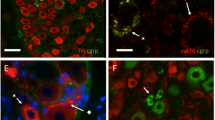Summary
The adrenergic innervation of the pelvic viscera was examined by the fluorescence histochemical technique, applied to tissue from untreated guinea-pigs and from guinea-pigs in which nerve pathways had been interrupted at operation. It was found that adrenergic neurons in the inferior mesenteric ganglia give rise to axons which run in the colonic nerves and end in the myenteric and submucous plexuses and around the arteries of the distal colon. In the rectum, part of the innervation of the myenteric plexus and all of the innervation of the submucous plexus comes from the inferior mesenteric ganglia. The rest of the adrenergic innervation of the myenteric plexus comes from the posterior pelvic ganglia or the sacral sympathetic chains. The innervation of the blood vessels of the rectum is from the posterior pelvic ganglia. Adrenergic nerves run from the sacral sympathetic chains and pass via nerves accompanying the rectal arteries to the internal anal sphincter. Other adrenergic fibres to the internal anal sphincter either arise in, or pass through, the posterior pelvic plexuses. The anal accessory muscle is innervated by adrenergic axons arising in the posterior pelvic plexuses. Adrenergic nerves which run in the pudendal nerves, probably from the sacral sympathetic chains, innervate the erectile tissue of the penis.
Similar content being viewed by others
References
Bunch, J. L.: On the origin, course and cell-connections of the viscero-motor nerves of the small intestine. J. Physiol. (Lond.) 22, 357–379 (1898).
Costa, M., Furness, J. B.: Observations on the anatomy and amine histochemistry of the nerves and ganglia which supply the pelvic viscera and on the associated chromaffin tissue in the guinea-pig. Z. Anat. Entwickl.-Gesch. 140, 85–108 (1973).
Costa, M., Furness, J. B., Gabella, G.: Catecholamine containing nerve cells in the mammalian myenteric plexus. Histochemie 25, 103–106 (1971).
Costa, M., Gabella, G.: Adrenergic innervation of the alimentary canal. Z. Zellforsch. 122, 357–377 (1971).
Elliott, T. R.: On the innervation of the ileo-colic sphincter. J. Physiol. (Lond.) 31, 157–168 (1904).
Furness, J. B.: The origin and distribution of adrenergic nerve fibres in the guinea-pig colon. Histochemie 21, 295–306 (1970).
Furness, J. B., Costa, M.: Morphology and distribution of intrinsic adrenergic neurones in the proximal colon of the guinea-pig. Z. Zellforsch. 120, 346–363 (1971).
Furness, J. B., Costa, M.: The ramifications of adrenergic terminals in the rectum, anal sphincter and anal accessory muscles of the guinea-pig. Z. Anat. Entwickl.-Gesch. 140, 109–128 (1973a).
Furness, J. B., Costa, M.: The adrenergic innervation of the gastrointestinal tract. Ergebn. Physiol. (in press, 1973b).
Langley, J. N.: The sympathetic and other related systems of nerves. In: Textbook of physiology, vol. 2, ed. E. A. Schäfer, p. 616–696. Edinburgh-London: Y. J. Pentland 1900.
Langley, J. N., Anderson, H. K.: The constituents of the hypogastric nerves. J. Physiol. (Lond.) 17, 177–191 (1894–1895).
Langley, J. N., Anderson, H. K.: On the innervation of the pelvic and adjoining viscera. Part I. The lower portion of the intestine. J. Physiol. (Lond.) 18, 67–105 (1895a).
Langley, J. N., Anderson, H. K.: The innervation of the pelvic and adjoining viscera. Part III. The external generative organs. J. Physiol. (Lond.) 19, 85–121 (1895b).
Langley, J. N., Anderson, H. K.: The innervation of the pelvic and adjoining viscera. Part V. Position of the nerve cells on the course of the efferent fibres. J. Physiol. (Lond.) 19, 131–139 (1895c).
Langley, J. N., Dickinson, W. L.: On the local paralysis of the peripheral ganglia and on the connexion of different classes of nerve fibres with them. Proc. roy. Soc. 46, 423–431 (1889).
Learmonth, J. R., Markowitz, J.: Studies on the function of the lumbar sympathetic outflow. I. The relation of the lumbar sympathetic outflow to the sphincter ani internus. Amer. J. Physiol. 89, 686–691 (1929).
Author information
Authors and Affiliations
Additional information
This work was supported by grants from the Australian Research Grants Committee and the National Health and Medical Research Council. We thank Professor G. Burnstock for his generous support.
Rights and permissions
About this article
Cite this article
Costa, M., Furness, J.B. The origins of the adrenergic fibres which innervate the internal anal sphincter, the rectum, and other tissues of the pelvic region in the guinea-pig. Z. Anat. Entwickl. Gesch. 140, 129–142 (1973). https://doi.org/10.1007/BF00520326
Received:
Issue Date:
DOI: https://doi.org/10.1007/BF00520326




